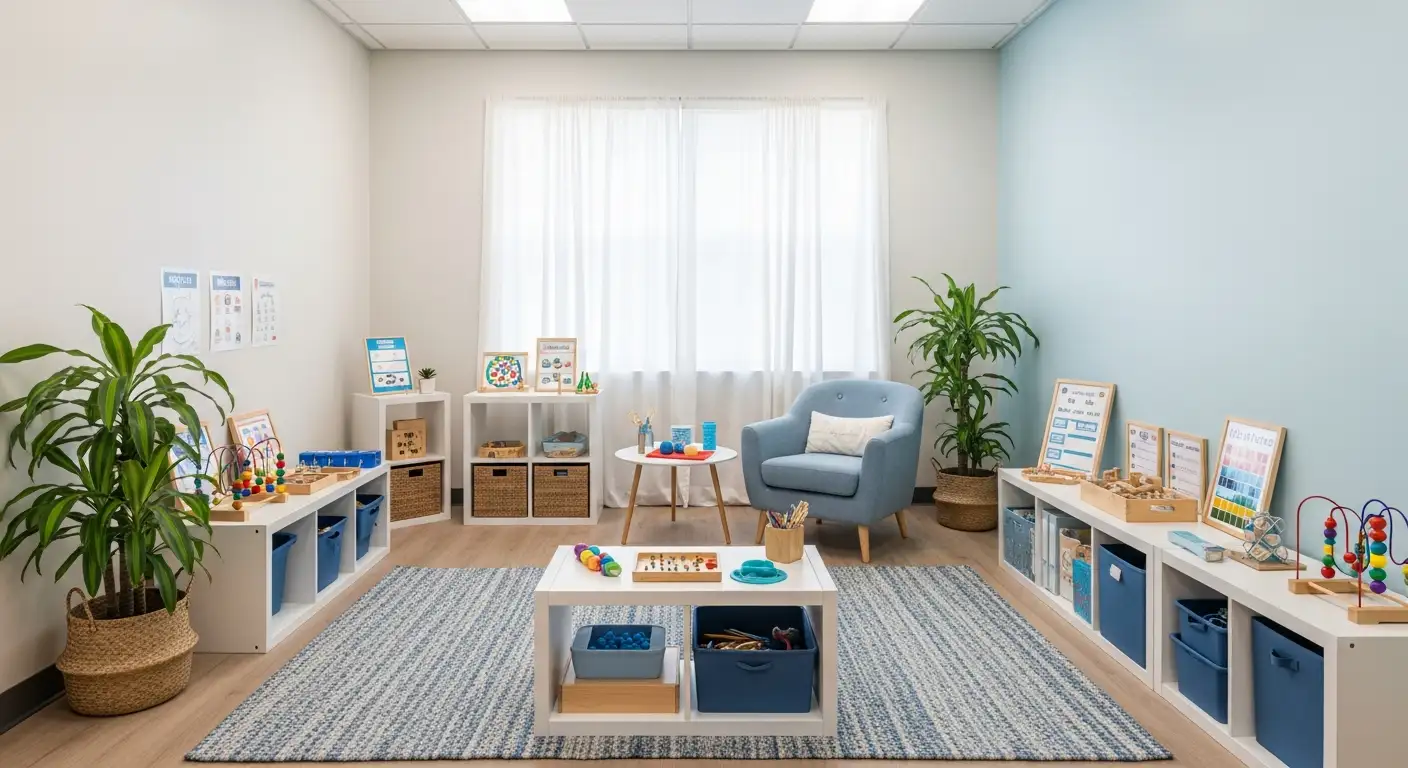Understanding the Impact of Community-Based ABA Therapy on Social Skills
Community-based Applied Behavior Analysis (ABA) therapy has emerged as a vital approach for enhancing social skills in children with autism spectrum disorder (ASD). By integrating intervention into natural settings such as neighborhoods, schools, and community activities, this therapeutic approach effectively bridges the gap between clinical skills and real-world social interactions. This article explores how community-based ABA therapy facilitates social development, promotes inclusion, and fosters greater independence, ultimately improving the quality of life for children with autism.
The Core Benefits of Community-Based ABA in Social Skills Development

What are the benefits of community-based ABA therapy for social skills development in children with autism?
Community-based ABA therapy provides significant advantages for children with autism aiming to develop social skills. Unlike traditional settings, this approach immerses children in real-world environments such as parks, sports fields, grocery stores, and community centers. These natural contexts are ideal for practicing social interactions authentically, which boosts a child's ability to transfer learned skills into everyday life.
One of the primary benefits is the promotion of skill generalization and long-term maintenance. Children learn to initiate conversations, share, take turns, and interpret social cues amid various social settings. This variety helps them better understand social norms and expectations across different situations.
Community involvement plays a vital role. Skilled ABA therapists work closely with parents, caregivers, and community staff to support consistent application of strategies like role-playing and positive reinforcement. These techniques are used to teach children how to respond appropriately to peers, make eye contact, recognize emotions, and navigate challenging interactions confidently.
As children practice these skills repeatedly in natural settings, their self-confidence and independence naturally grow. They become more comfortable managing social cues and engaging in meaningful interactions without assistance. This inclusive approach helps reduce social anxiety and challenging behaviors such as tantrums or withdrawal.
Overall, community-based ABA fosters social understanding, promotes inclusion in recreational and educational activities, and empowers children to participate actively and confidently in their communities. It shifts the focus from rote learning to functional, real-world skills that support ongoing social success.
How does ABA therapy support the development of social skills?
ABA therapy incorporates systematic techniques like role-playing, modeling, chaining, and reinforcement to teach social skills. These methods break down complex behaviors into manageable steps, making learning more accessible.
Therapists set personalized goals based on thorough assessments, ensuring that skill development aligns with each child's needs, strengths, and interests. They initially work in one-on-one settings to teach foundational skills such as understanding emotions, initiating conversations, and respecting boundaries.
Once mastered, these skills are gradually practiced in peer group settings and community environments. This systematic progression helps children generalize their behaviors in different social contexts.
For example, a child learns to recognize a peer’s emotional cue in therapy and then applies this skill when playing with friends at the park. Consistent reinforcement and encouragement solidify these behaviors, making them habitual.
Specialized strategies such as shaping (reinforcing closer approximations to the desired behavior), modeling (demonstrating behaviors), and chaining (linking steps to produce a complex skill) facilitate this learning process effectively.
What social skills can ABA therapy help develop?
ABA therapy targets a broad spectrum of social skills essential for meaningful interactions:
- Reciprocal conversations
- Identifying and responding to emotions
- Nonverbal communication cues (gestures, facial expressions)
- Interactive play and group activities
- Active listening and turn-taking
- Sharing and respecting boundaries
- Following directions in social settings
- Collaborating with peers
- Self-advocacy and expressing needs
Through tailored teaching, children learn to understand social nuances, develop empathy, and maintain relationships. These skills serve as a foundation for a successful social life, enhancing inclusion and personal growth.
Techniques for effective social skills teaching
ABA employs a variety of evidence-based methods to facilitate social skills development:
| Technique | Description | Application in Social Skills |
|---|---|---|
| Goal Setting | Establishing clear, measurable targets | Defining specific skills like initiating greetings |
| Skill Breakdown | Dividing complex skills into small steps | Teaching |
Effective Techniques for Teaching Social Skills in Community Settings
What techniques are used in community-based ABA therapy to improve social skills?
Community-based ABA therapy utilizes a range of proven strategies to help children with autism develop essential social skills. These methods are tailored to the child's unique needs and situations, ensuring effective learning.
One fundamental technique is positive reinforcement, which rewards desired behaviors to encourage repetition. For example, praising a child for initiating a conversation or sharing a toy can motivate continued use of those skills.
Modeling is another key approach. Therapists and peers demonstrate appropriate social actions—such as making eye contact, taking turns, or responding to greetings—so children can imitate these behaviors.
Role-playing allows children to practice social scenarios in a controlled, safe environment. For instance, practicing how to ask for help or introduce themselves helps prepare children for real-life interactions.
Social stories are used to teach specific social skills by providing simple, illustrated narratives that explain expected behaviors in various situations. This helps children understand social cues and appropriate responses.
Group activities and peer interactions foster socialization and collaboration. Children engage in activities that require sharing, turn-taking, and working together, often facilitated by behavior analysts like BCBAs.
To systematically address complex social behaviors, therapists employ techniques such as shaping—reinforcing successive approximations towards a target behavior—and chaining, which teaches complex skills by breaking them into smaller, manageable steps.
All these strategies contribute to promoting independence and generalization, enabling children to apply their new skills naturally in community settings like parks, stores, and school environments.
| Technique | Purpose | How It Works |
|---|---|---|
| Positive Reinforcement | Encourages repetition of desired social behaviors | Rewards like praise or tokens reinforce desirable actions |
| Modeling | Teaches behaviors through demonstration | Child observes and imitates behaviors demonstrated by adults or peers |
| Role-playing | Prepares children for real social scenarios | Practice simulated interactions to build confidence |
| Social Stories | Explains social norms and expectations | Illustrated stories clarify appropriate behaviors in context |
| Group Activities | Promotes peer interaction and socialization | Activities like sharing and turn-taking under supervision |
How are goals for social behavior customized?
Goals are created based on detailed assessments of each child's strengths, needs, and interests. Behavioral objectives focus on specific social skills, such as initiating conversations, understanding emotions, or respecting personal space.
Therapists set measurable, achievable targets and systematically teach these skills through individualized plans. Skills are often taught sequentially, starting with basic social interactions and progressing to more complex behaviors like engaging in reciprocal conversations.
These personalized goals ensure that therapy directly addresses the child's unique social challenges, making progress more meaningful and sustainable.
Facilitating Social Integration in Schools and Communities
Community-based ABA therapy plays a crucial role in helping children with autism participate actively in school and community settings. By providing personalized interventions, therapists teach essential social skills such as reading social cues, engaging in turn-taking, and effective communication.
In real-world environments, therapy sessions include structured activities like role-playing, social stories, and guided peer interactions. These methods help children learn how to navigate social situations successfully, making skills more applicable outside the therapy setting.
Collaboration is a vital element of community-based ABA. Therapists work closely with teachers, parents, and community members to create supportive environments that encourage social participation. This teamwork ensures that interventions are consistent and tailored to each child's needs.
Promoting inclusion and reducing feelings of isolation are primary goals. Through guided interactions, children build friendships and develop confidence. They learn to initiate conversations, share interests, and respect boundaries, fostering meaningful relationships.
Overall, community ABA therapy not only teaches social skills but also emphasizes their transfer to daily life. This approach supports children in becoming more independent and socially competent, which enhances their quality of life.
| Aspect | Approach | Additional Details |
|---|---|---|
| Teaching social cues and communication | Role-playing, social stories, peer interactions | Helps children interpret emotions and respond appropriately |
| Collaboration with community | Working with families, teachers, and peers | Ensures consistency and reinforces skills in natural settings |
| Promoting inclusion | Facilitating peer interactions, coaching on social norms | Aims to reduce social barriers and foster friendships |
| Supporting independence | Practice in real-world settings, community outings | Encourages generalization and confidence |
| Addressing challenges | Real-time behavior management, social coaching | Supports positive social engagement |
Outcomes and Long-Term Benefits of Community ABA Therapy

What are the outcomes and advantages of community-based ABA therapy in improving social interaction and independence?
Community-based ABA therapy plays a vital role in enhancing social skills and independence for children with autism. By starting early, especially before age five, children can make substantial improvements in communication, social engagement, and daily living skills. This proactive approach helps children better adapt to various community settings, such as school, recreational areas, and public spaces.
One of the significant benefits is the use of naturalistic teaching methods within real-world environments. These techniques promote the generalization of skills beyond the therapy room, enabling children to initiate conversations, share toys, and take turns in everyday interactions.
Therapists tailor programs with personalized goals, focusing on breaking down complex social behaviors into manageable steps. Techniques like modeling, shaping, chaining, and positive reinforcement ensure children learn to read social cues, understand emotions, and respect boundaries. These skills foster meaningful relationships and improve overall social participation.
Consistent, data-driven sessions involving families ensure that progress is maintained over time. Training family members and integrating therapy into daily routines help youngsters transfer skills across different settings, boosting their confidence and independence.
Beyond social interaction, community-based ABA therapy enhances broader skills such as adaptive living, self-care, and behavioral management. As children learn to navigate their social environment successfully, they experience a better quality of life, increased autonomy, and greater inclusion in community activities.
Overall, community ABA provides a comprehensive approach that not only teaches social skills but also promotes long-term development, helping children reach their full potential and live more engaged and independent lives.
Addressing Social Challenges and Building Confidence

How does community-based ABA therapy address social challenges such as social anxiety?
Community-based ABA therapy plays a crucial role in helping children with autism overcome social challenges like social anxiety. It provides real-world settings where children can learn to interpret social cues, express themselves, and develop effective coping strategies.
Through techniques such as modeling and role-playing, children practice social interactions in a safe and controlled environment. These methods allow them to experience social situations repeatedly, helping to reduce fear and build confidence.
The therapy also focuses on reducing distress by teaching children to manage their emotions and respond appropriately during social encounters. Positive reinforcement encourages desired social behaviors, making interactions more rewarding.
As children become more comfortable, they are better able to initiate conversations, maintain relationships, and navigate various social contexts. This gradual exposure and skill development foster resilience and emotional understanding, which are essential for successful inclusion in social activities and community settings.
In summary, ABA therapy addresses social anxiety by combining structured practice with emotional regulation strategies, empowering children to face social environments with greater confidence and independence.
Developing Functional and Lasting Social Skills
ABA therapy employs a systematic approach to teaching social skills, which involves breaking down complex behaviors into smaller, manageable steps. This careful method allows children to learn each component thoroughly and build upon them progressively.
One of the critical techniques used is skill breakdown, where social behaviors like initiating a conversation or interpreting emotions are divided into specific actions. This makes learning more attainable for children, especially those with ASD who may find social interactions challenging.
Systematic teaching methods such as shaping, modeling, chaining, and positive reinforcement play vital roles in this process. Shaping involves rewarding successive approximations toward a targeted behavior, encouraging gradual improvement. Modeling provides children with clear examples of desired behaviors by demonstrating social interactions. Chaining connects individual steps into comprehensive routines, enabling children to perform complex social skills as a sequence. Positive reinforcement motivates children to repeat successful behaviors by offering praise or tangible rewards.
In community-based ABA therapy, emphasis is placed on real-world application, allowing children to practice skills in natural settings like playgrounds, stores, or at school. This exposure helps bridge the gap between therapy sessions and everyday life, fostering better generalization.
Starting with one-on-one sessions, therapists build programs tailored to each child's strengths, needs, and interests. Over time, children are encouraged to practice independently, promoting confidence and autonomy.
By consistently applying these structured, step-by-step teaching methods, children develop social skills that are both functional and enduring. They learn to navigate social environments more effectively, increase their independence, and build meaningful relationships.
For more insights, search for "systematic teaching in community-based ABA" to explore how these strategies are implemented and their effectiveness in promoting lasting social development.
Family Involvement and Support for Skill Generalization

How does involving families in community-based ABA therapy support social skills development?
Family participation plays a vital role in enhancing the effectiveness of ABA therapy, especially in community settings. When families are actively involved, they help ensure that the social skills learned during therapy are consistently reinforced across different environments.
Therapists work closely with parents and caregivers, providing training and practical strategies to support skill practice at home and in other natural settings. This partnership creates a seamless support system, helping children apply new skills such as initiating conversations, sharing toys, and understanding social cues in real-world situations.
A collaborative approach not only boosts confidence in caregivers but also enhances the child's ability to transfer learned behaviors beyond the therapy room. This consistency across environments encourages children to develop lasting social abilities, making progress more sustainable.
Research indicates that family involvement can significantly improve social skills outcomes, as it fosters understanding, reinforces positive behaviors, and helps address specific challenges like social anxiety or difficulty interpreting social cues.
Overall, engaging families in community-based ABA therapy helps children practice and generalize their social skills, promoting greater inclusion in social, educational, and recreational activities.
Summary table of how family involvement supports social skills development
| Aspect | How It Supports | Additional Details |
|---|---|---|
| Training families and caregivers | Provides them with tools and strategies | Ensures skills are reinforced consistently at home |
| Consistency across environments | Strengthens skill transfer | Helps children apply social skills in various settings |
| Collaborative approach | Builds a support network | Fosters shared goals and ongoing communication |
In summary, when families actively participate in ABA therapy, children benefit from a more cohesive learning experience. This engagement fosters confidence, encourages continued practice, and ultimately leads to improved social integration and independence.
Empowering Children for a Socially Inclusive Future
In conclusion, community-based ABA therapy plays a transformative role in nurturing social skills and fostering independence among children with autism. By providing real-life practice opportunities, employing systematic teaching techniques, and involving families, this approach ensures that children can navigate diverse social environments confidently and successfully. As a result, these children are better equipped to participate meaningfully in their communities, develop lasting relationships, and lead more independent lives. With ongoing support and tailored interventions, community-based ABA therapy offers a promising pathway towards social integration and inclusive development for children with autism.
References
- How ABA Therapy Enhances Social Skills in Children with ASD
- How ABA Therapy Helps With Social Skills
- Community Based ABA Therapy - Bluesprig Autism
- How ABA Therapy Can Benefit Children with Autism
- How ABA Therapy Enhances Social Skills in Children with ASD
- Building Social Skills Through ABA Therapy
- How ABA Therapy Helps With Social Skills
- Community Based ABA Therapy - Bluesprig Autism










